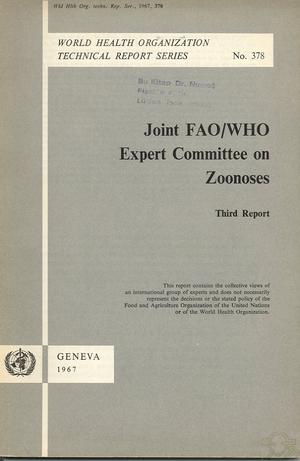Join FAO/WHO Expert Committee on Zoonoses
İÇİNDEKİLERCONTENTS Introduction.......................... 1. Definition and classification of zoonoses............ 2. Prevention, control, and eradication............. 3. Collection of information on occurrence........... 3.1 Reporting...................... 3.2 Surveillance..................... 3.3 Surveys....................... 4. Zoonoses as occupational hazards and their economic implications 5. Viral infections...................... 5.1 Arbovirus infections................. 5.2 Influenza in animals and its relation to influenza in human beings....................... 5.3 Herpes virus infections in monkeys.......... 5.4 Poxvirus infections.................. 5.5 Foot-and-mouth disease............... 6. Rickettsial infections.................... 6.1 Q fever....................... 7. Bedsonial infections.................... 7.1 Avian psittacosis-ornithosis.............. 7.2 Mammalian bedsonial infections............ 7.3 Epidemiology.................... 7.4 Diagnosis...................... 7.5 Therapy and control................. 7.6 International transfer of psittacine birds........ 8. Bacterial infections..................... 8.1 Salmonellosis .................... 8.2 Tuberculosis..................... 8.3 Anthrax....................... 8.4 Leptospirosis.................... 8.5 Colibacillosis.................... 8.6 Tularaemia..................... 8.7 Listeriosis...................... 8.8 Pasteurella pestis and P. pseudotuberculosis infections . . 8.9 Pasteurellamultocida and P. haemotytica infections. . . . 8.10 Staphylococcosis................... 8.11 Tick-borne relapsing fever.............. 9. Fungal infections..................... 9.1 Systemic fungal infections............... 9.2 Dennatophytoses...................10. Protozoan infections.................... 10.1 Toxoplasmosis.................... 10.2 Leishmaniasis.................... 10.3 Trypanosomiasis................... 10.4 Pneumocystis carinii infection............. 10.5 Malaria....................... 11. Cestode infections..................... 11.1 Echinococcosis (hydatidosis).............. 11.2 Taeniasis and cysticercosis.............. 12. Trematode infections.................... 12.1 Clonorchiasis and opisthorchiasis........... 12.2 Fascioliasis..................... 12.3 Fasciolopsiasis.................... 12.4 Paragonimiasis.................... 12.5 Schistosomiasis................... 13. Nematode infections.................... 13.1 Trichinosis..................... 13.2 Larva migrans.................... 14. Filariasis......................... 15. Localization of zoonoses and the ecology of natural foci of infection 16. Emerging zoonoses..................... Annex 1. A system for the classification of zoonoses...... Annex 2. Partial list of zoonoses................ Annex 3. Reporting of zoonoses................ Annex 4. Functions of the WHO International Salmonella Centre and of national Salmonella centres............ Annex 5. List of serotypes of leptospires isolated from man and animals...................... Annex 6. WHO/FAO leptospirosis reference laboratories..... Annex 7. Control of tuberculosis in cattle........... Annex 8. Anthrax : outline of wool-sterilization process used in the United Kingdom.................. Annex 9. Anthrax: procedures recommended in plants where potentially contaminated materials are handled....... Annex 10. Medicated feed for psittacosis control in budgerigars and parrots....................... Annex 11. Echinococcosis control in Iceland and New Zealand . .    |



